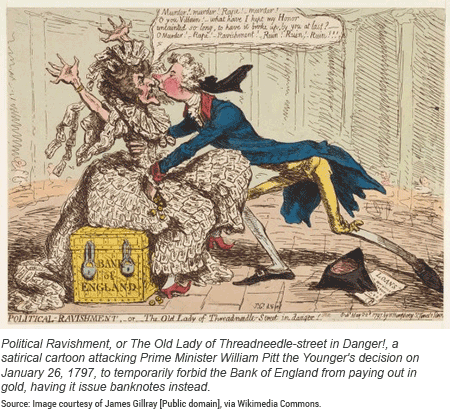It’s almost Valentine’s Day, and we’re not asking you questions or dispensing advice about it—that’s not (yet) our business. However, we can offer two attempts at humor regarding the Bank of England and amorous activity. The first touches upon a central bank’s fear for its reputation and the second its fear of being “manhandled” by the government.
London’s Punch magazine (1841-2002) had in its October 18, 1873, issue a little satirical story (scroll down to “New Bank Stock”) about the discovery of a stack of love letters in the Bank of England’s vault and the turmoil that ensued. It reported:
Odd things come to light in odd places. An unexpected discovery has just been made in that romantic spot, the Bank of England. A bundle, not of old cheque-books, or old dividend warrants or old notes, but of “old love letters,” has been found in a chest in the vaults of that matter-of fact building . . . The Governor, Deputy-Governor, and all the Directors were at once summoned. They would have been glad if the discovery in the vaults could have been kept a profound secret, apprehensive of the effect it might produce upon the next half-yearly dividend. The Solicitors to the Bank assured them that no breach of its Charter had been committed. All sorts of rumours were in circulation, and confidence in the character of the Bank for steadiness was not restored, until it was ascertained that the letters dated back a far as the Restoration of CHARLES THE SECOND, and were not, as had been feared, the tender effusions of some sentimental Director or susceptible Chief Cashier of more modern times. Restoration of the letters has been made to the present representative or the original writer (who the young lady was does not appear), and the Old Lady is again tranquil. The Rest of the Bank is no longer disturbed, its Stock is as valuable as ever, and no alteration in the rate of discount is apprehended.
The “Old Lady” is the Bank of England itself of course, the full phrase being “The Old Lady of Threadneedle Street”—and that brings us to our next Bank of England love (well, OK, taking-advantage-of) story.
John Keyworth, curator of the Bank of England’s museum, has provided on the Bank’s website a full explanation for why the institution is called “The Old Lady of Threadneedle Street.” It stems from an elaborate 1797 satirical cartoon created by James Gillray. The author’s words best explain what is going on in the cartoon:
The cartoon shows the Prime Minister of the day, William Pitt the Younger, pretending to woo an old lady, the personification of the Bank, but what he is really after is the Bank’s reserves, represented by the gold coin in her pocket, and the money-chest on which she is firmly seated. At the time, the Bank was a joint-stock company operating under Royal Charter, and therefore essentially a private company—and so it was perceived as having been taken advantage of by the politicians. A series of events beginning with a landing in February 1797 by several hundred French troops at Fishguard on the Welsh coast and ending with an accusatory speech in the House of Commons by the opposition MP [Member of Parliament] Richard Sheridan had prompted Gillray to produce the cartoon.
The Fishguard incident was perceived by many as a precursor to the long-expected French invasion and sparked a panic. The Bank was inundated by holders of notes wanting to exchange them for gold and its reserves were reduced within a fortnight from £16 million to less than £2 million. This situation could not be sustained and an order was passed releasing the Bank from its obligation to pay its notes in gold. Known as the ‘Restriction of Cash Payments’ or simply ‘The Restriction Period’, it had the effect of reserving the gold in circulation and the Bank’s vaults for the war effort. The Restriction Period continued until 1821. Unsurprisingly, this action was seen by the Government’s detractors as outrageous and Sheridan, representing the Whig opposition, described the Bank as ‘an elderly lady in the City who
had . . . unfortunately fallen into bad company’.Gillray, from his workplace in St James’s, latched onto Sheridan’s words. Dressed in a gown made of the new £1 and £2 notes issued to supplant the gold coin in circulation, an old lady sits protectively on a chest representing the Bank’s reserves, declaiming against the unwanted attentions of the skeletal, freckle-faced, pointy-nosed Pitt. The scene is set in the Rotunda, a well-known public office in the Bank’s Threadneedle Street building. Clerks seated at their desks can just be discerned in the background. A document headed ‘Loans’ refers to the Pitt administration’s continual demands on the Bank for funds.
Don’t miss the other fascinating cartoons with explanations in the same publication. Coincidentally, there is an upcoming exhibition at Oxford University’s Ashmolean Museum of Gillray’s work called “Love Bites.”
Disclaimer
The views expressed in this post are those of the author and do not necessarily reflect the position of the Federal Reserve Bank of New York or the Federal Reserve System. Any errors or omissions are the responsibility of the author.
Amy Farber is a research librarian in the Federal Reserve Bank of New York’s Research and Statistics Group.











 RSS Feed
RSS Feed Follow Liberty Street Economics
Follow Liberty Street Economics
When I joined the Bank, I was told that the term ‘Old Lady’ predated Gillray and that he was alluding to an earlier usage that derived from the image of Britannia on the Bank’s insignia. Illiterate messengers would navigate by such signs and would refer to them when giving direction, eg ‘Look for the old lady’.